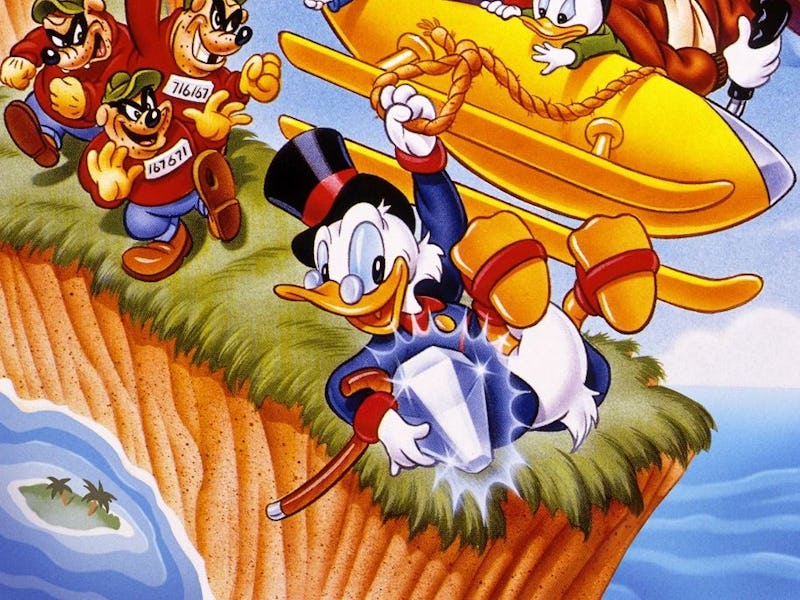How Sega and Disney Made an All-Time Classic ‘90s Game
A legendary game worthy of one of the decade’s biggest hits.

Diamonds aren’t made from coal. Most people think they are (I blame Superman 3) but coal is made from plants and diamonds are actually older than plants. They’re formed deep in the mantle of the Earth under conditions we cannot even comprehend. A white-hot crystal of purest carbon churning under the literal weight of the world. They also make for great metaphors, but this isn’t a time + pressure story. It’s a story that shows us how little we know about the things we love. Like diamonds, or DuckTales.
DuckTales debuted on the Nintendo Entertainment System in 1989, courtesy of some white-hot energy of its own. It was based on the popular kids’ TV show anchoring a Disney Afternoon programming block known for other classics like Talespin and Chip ‘n’ Dales Rescue Rangers. This children’s television strategy, the brainchild of then-CEO Michael Eisner, endured controversy at the outset for hiring Japanese animation studio TMS Entertainment for the production instead of an internal Disney crew. It proved successful and laid the groundwork for Disney to partner with another Japanese company for the video game: Capcom.
In the NES era, if you thought of Capcom, you probably thought of Mega Man. By the time Disney released DuckTales, Capcom was already two games deep into the Mega Man franchise. Mega Man 2, in particular, had been a massive success moving more than one million units at retail. It solidified a new approach to platformers with an emphasis on timing, speed, and level design that captivated audiences and influenced game design for generations. So when Disney approached Capcom about this partnership, the Japanese giant put the minds behind Mega Man to work.
Mega Man producer Tokuro Fujiwara, character designer Keiji Inafune, and sound programmer Yoshihiro Sakaguchi were brought on board to assemble the dev team and make a game worthy of the Disney brand. Two U.S. producers, David Mullich and Darlene Lacey, served as the liaisons for Disney to make sure the game was in line with the company’s vision. Mullich, in particular, was instrumental in getting the Capcom crew immersed in Disney culture and values, going so far as to give them a guided tour of Disneyland.
This is essentially the “secret sauce” behind DuckTales. Today, it holds a vaunted place in Nintendo history and is tattooed on the collective memories of ‘90s kids, but at the time, it was uncharted territory for both Capcom and Disney. Video games based on movies and TV shows have a spotty legacy at best, so when you wonder what made DuckTales so good and hear “Mega Man devs” it makes a lot of sense. It made a lot of cents, too. Scrooge McDuckian levels of cash that eventually usurped Mega Man 2 in sales and became Capcom’s bestselling NES title of all time.
One look at the level select screen and it’s easy to see the Mega Man influence at work.
So what made DuckTales so good? In this side-scrolling platformer full of gorgeous art and colorful backgrounds, players control Scrooge McDuck as he embarks on a treasure hunt across five unique levels: The Amazon, The Himalayas, Transylvania, The African Mines, and The Moon. Like in Mega Man, each level is non-linear, encouraging exploration and revisiting sections to find hidden treasures and secret paths.
Character cameos are everywhere, from nephews Huey, Dewey, and Louie to the lantern-jawed pilot Launchpad McQuack. The atmosphere captures the spirit of the show and delivers on the fantasy of allowing players to feel like they’re controlling the cartoon. The soundtrack helps too, with a rousing 8-bit rendition of DuckTales iconic theme.
Scrooge’s pogo-jumping cane is the key gameplay mechanic, allowing him to stomp on enemies, break obstacles, and traverse dangerous terrain. It was also a solution to a major sticking point from Disney: violent gameplay. Mega Man may seem tame by today’s standards, but if you see it through the ‘80s eyes of cautious execs you’ll see a game full of shooting, explosions, and murder.
Scrooge can bounce on enemies or swat them with a golf-style swing, but they don’t explode or collapse into a pile. Instead, they just bounce off-screen, presumably to a safe landing where they learn the errors of their ways and move on to a more wholesome lifestyle. Just like Walt would’ve wanted.
Just a family-friendly billionaire pogo sticking his way through the Amazon.
DuckTales was a major success, but Capcom couldn’t follow through to make it a proper franchise. A Game Boy port was well-received, but is essentially the same game. A follow-up sequel struck while the iron was ice cold, launching for NES in 1993 at the end of the console’s lifecycle after most fans had moved on to the Super Nintendo. It offered no changes or new ideas and feels more like what modern gamers recognize as DLC than a standalone title.
A myriad of mobile games and other DuckTales properties trickled out over the years but the most successful venture was a reboot of the original NES game in 2013. DuckTales: Remastered from WayForward Technologies is a loving homage to the original with souped-up graphics and gameplay that showcase the strength of Capcom’s foundational game design. Like most reboots, it helps to have grown up with the game, although new players may enjoy it simply as a piece of gaming history.
DuckTales’ 35th anniversary serves as a reminder that our most beloved games often benefit from hindsight that paints them as a sure thing. DuckTales was anything but a guaranteed success. From its roots as a television cartoon that broke away from Disney’s longstanding animation traditions to a risky international partnership in a pre-internet era when collaboration was built on pen, paper, and snail mail, DuckTales managed to rewrite history.